sensor KIA RIO 2022 Owner's Manual
[x] Cancel search | Manufacturer: KIA, Model Year: 2022, Model line: RIO, Model: KIA RIO 2022Pages: 528, PDF Size: 11.8 MB
Page 276 of 528
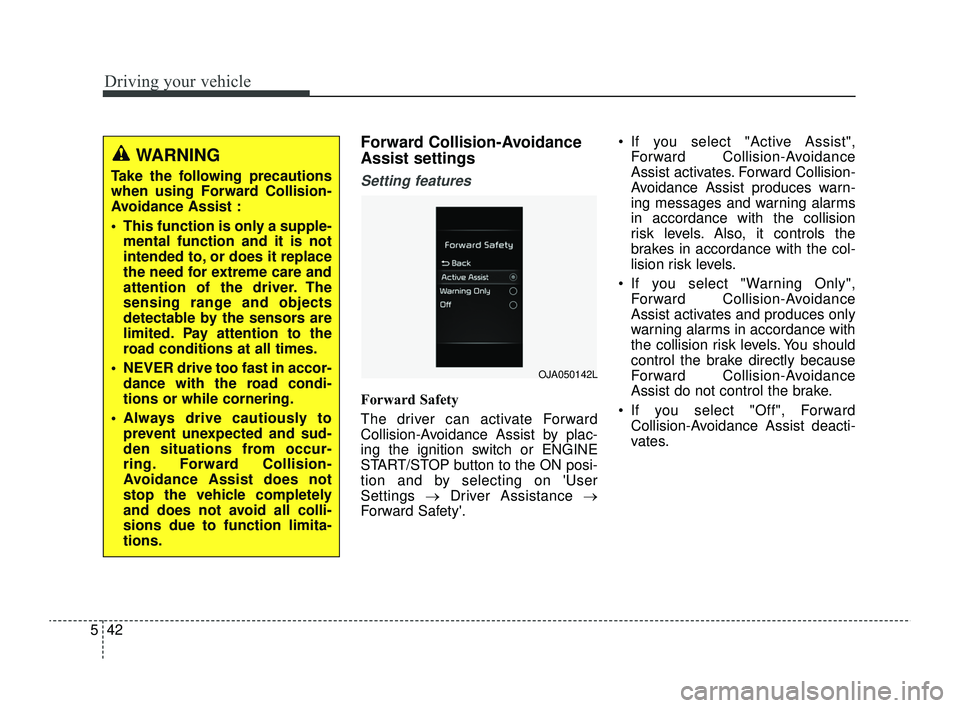
Driving your vehicle
42
5
Forward Collision-Avoidance
Assist settings
Setting features
Forward Safety
The driver can activate Forward
Collision-Avoidance Assist by plac-
ing the ignition switch or ENGINE
START/STOP button to the ON posi-
tion and by selecting on 'User
Settings →Driver Assistance →
Forward Safety'. If you select "Active Assist",
Forward Collision-Avoidance
Assist activates. Forward Collision-
Avoidance Assist produces warn-
ing messages and warning alarms
in accordance with the collision
risk levels. Also, it controls the
brakes in accordance with the col-
lision risk levels.
If you select "Warning Only", Forward Collision-Avoidance
Assist activates and produces only
warning alarms in accordance with
the collision risk levels. You should
control the brake directly because
Forward Collision-Avoidance
Assist do not control the brake.
If you select "Off", Forward Collision-Avoidance Assist deacti-
vates.
WARNING
Take the following precautions
when using Forward Collision-
Avoidance Assist :
This function is only a supple-mental function and it is not
intended to, or does it replace
the need for extreme care and
attention of the driver. The
sensing range and objects
detectable by the sensors are
limited. Pay attention to the
road conditions at all times.
NEVER drive too fast in accor- dance with the road condi-
tions or while cornering.
Always drive cautiously to prevent unexpected and sud-
den situations from occur-
ring. Forward Collision-
Avoidance Assist does not
stop the vehicle completely
and does not avoid all colli-
sions due to function limita-
tions.
OJA050142L
SC PE USA 5.QXP 9/9/2021 6:18 PM Page 42
Page 281 of 528
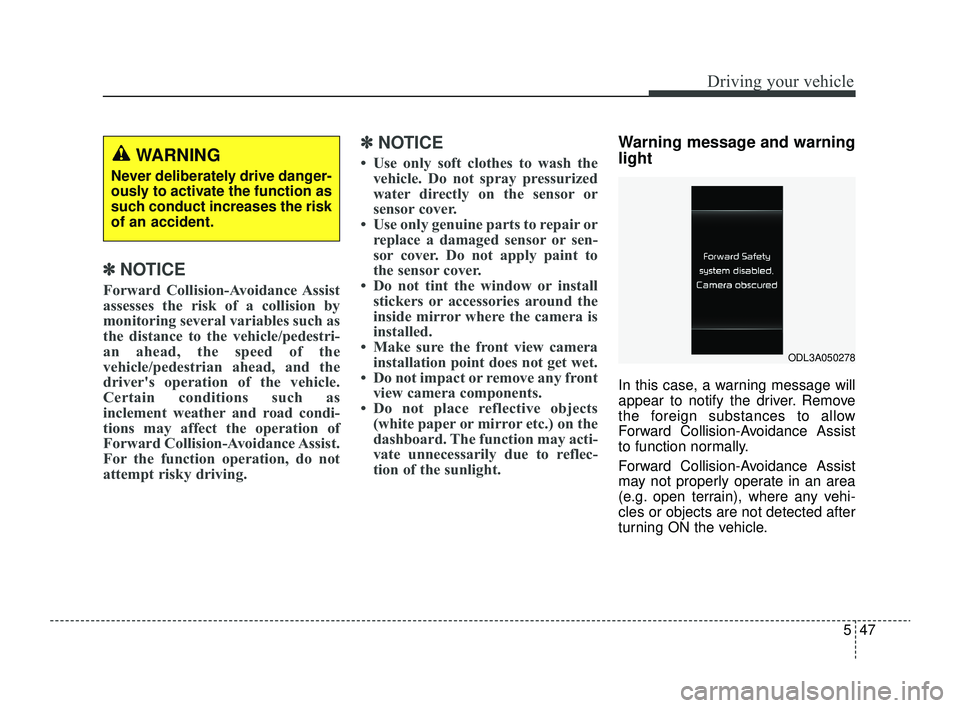
547
Driving your vehicle
✽ ✽NOTICE
Forward Collision-Avoidance Assist
assesses the risk of a collision by
monitoring several variables such as
the distance to the vehicle/pedestri-
an ahead, the speed of the
vehicle/pedestrian ahead, and the
driver's operation of the vehicle.
Certain conditions such as
inclement weather and road condi-
tions may affect the operation of
Forward Collision-Avoidance Assist.
For the function operation, do not
attempt risky driving.
✽ ✽NOTICE
• Use only soft clothes to wash the
vehicle. Do not spray pressurized
water directly on the sensor or
sensor cover.
• Use only genuine parts to repair or replace a damaged sensor or sen-
sor cover. Do not apply paint to
the sensor cover.
• Do not tint the window or install stickers or accessories around the
inside mirror where the camera is
installed.
• Make sure the front view camera installation point does not get wet.
• Do not impact or remove any front view camera components.
• Do not place reflective objects (white paper or mirror etc.) on the
dashboard. The function may acti-
vate unnecessarily due to reflec-
tion of the sunlight.
Warning message and warning
light
In this case, a warning message will
appear to notify the driver. Remove
the foreign substances to allow
Forward Collision-Avoidance Assist
to function normally.
Forward Collision-Avoidance Assist
may not properly operate in an area
(e.g. open terrain), where any vehi-
cles or objects are not detected after
turning ON the vehicle.
WARNING
Never deliberately drive danger-
ously to activate the function as
such conduct increases the risk
of an accident.
ODL3A050278
SC PE USA 5.QXP 9/9/2021 6:18 PM Page 47
Page 284 of 528
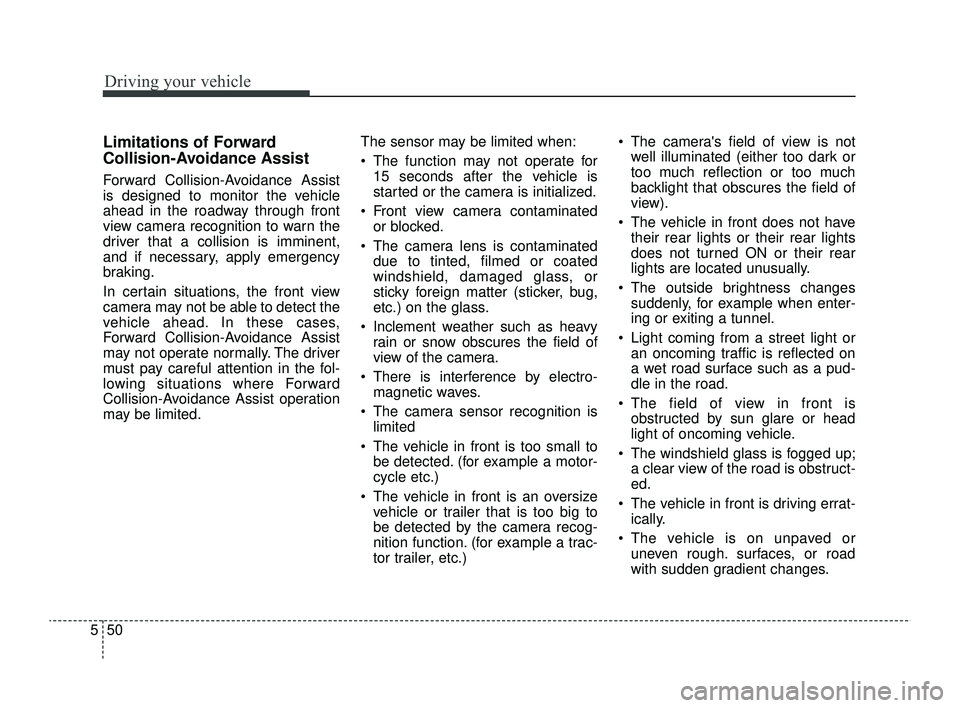
Driving your vehicle
50
5
Limitations of Forward
Collision-Avoidance Assist
Forward Collision-Avoidance Assist
is designed to monitor the vehicle
ahead in the roadway through front
view camera recognition to warn the
driver that a collision is imminent,
and if necessary, apply emergency
braking.
In certain situations, the front view
camera may not be able to detect the
vehicle ahead. In these cases,
Forward Collision-Avoidance Assist
may not operate normally. The driver
must pay careful attention in the fol-
lowing situations where Forward
Collision-Avoidance Assist operation
may be limited. The sensor may be limited when:
The function may not operate for
15 seconds after the vehicle is
started or the camera is initialized.
Front view camera contaminated or blocked.
The camera lens is contaminated due to tinted, filmed or coated
windshield, damaged glass, or
sticky foreign matter (sticker, bug,
etc.) on the glass.
Inclement weather such as heavy rain or snow obscures the field of
view of the camera.
There is interference by electro- magnetic waves.
The camera sensor recognition is limited
The vehicle in front is too small to be detected. (for example a motor-
cycle etc.)
The vehicle in front is an oversize vehicle or trailer that is too big to
be detected by the camera recog-
nition function. (for example a trac-
tor trailer, etc.) The camera's field of view is not
well illuminated (either too dark or
too much reflection or too much
backlight that obscures the field of
view).
The vehicle in front does not have their rear lights or their rear lights
does not turned ON or their rear
lights are located unusually.
The outside brightness changes suddenly, for example when enter-
ing or exiting a tunnel.
Light coming from a street light or an oncoming traffic is reflected on
a wet road surface such as a pud-
dle in the road.
The field of view in front is obstructed by sun glare or head
light of oncoming vehicle.
The windshield glass is fogged up; a clear view of the road is obstruct-
ed.
The vehicle in front is driving errat- ically.
The vehicle is on unpaved or uneven rough. surfaces, or road
with sudden gradient changes.
SC PE USA 5.QXP 9/9/2021 6:18 PM Page 50
Page 285 of 528

551
Driving your vehicle
The camera sensor recognition islimited
The vehicle in front is too small to be detected. (for example a motor-
cycle etc.)
The vehicle in front is an oversize vehicle or trailer that is too big to
be detected by the camera recog-
nition function. (for example a trac-
tor trailer, etc.)
The camera's field of view is not well illuminated. (either too dark or
too much reflection or too much
backlight that obscures the field of
view)
The vehicle in front does not have their rear lights or their rear lights
does not turned ON or their rear
lights are located unusually.
The outside brightness changes suddenly, for example when enter-
ing or exiting a tunnel.
Light coming from a street light or an oncoming vehicle is reflected on
a wet road surface such as a pud-
dle in the road.
The field of view in front is obstructed by sun glare or head
light of oncoming vehicle. The windshield glass is fogged up;
a clear view of the road is obstruct-
ed.
The vehicle in front is driving errat- ically.
The vehicle is on unpaved or uneven rough surfaces, or road
with sudden gradient changes.
The vehicle is driven near areas containing metal substances as a
construction zone, railroad, etc.
The vehicle drives inside a building, such as a basement parking lot.
The camera does not recognize the entire vehicle in front.
The camera is damaged.
The brightness outside is too low such as when the headlamps are
not on at night or the vehicle is
going through a tunnel.
The shadow is on the road by a median strip, trees, etc.
The vehicle drives through a toll- gate.
The windshield glass is fogged up; a clear view of the road is obstruct-
ed. The rear part of the vehicle in front
is not normally visible. (The vehicle
turns in other direction or the vehi-
cle is overturned.)
The adverse road conditions cause excessive vehicle vibrations while
driving.
The sensor recognition changes suddenly when passing over a
speed bump.
The vehicle in front is moving verti- cally to the driving direction.
The vehicle in front is stopped ver- tically.
The vehicle in front is driving towards your vehicle or reversing.
You are on a roundabout and the vehicle in front circles.
SC PE USA 5.QXP 9/9/2021 6:18 PM Page 51
Page 289 of 528
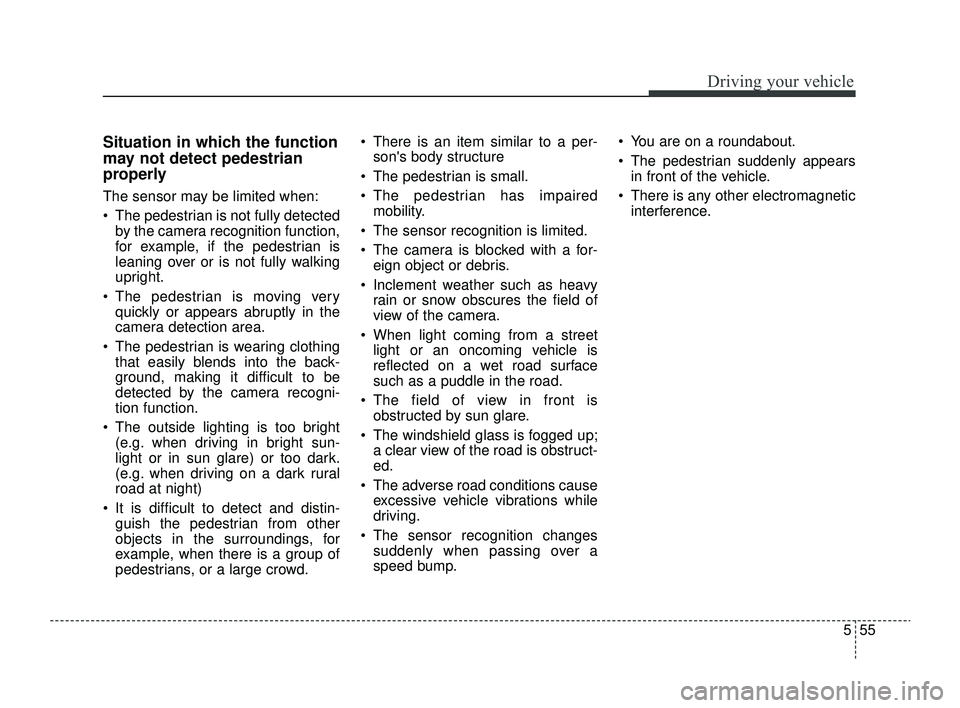
555
Driving your vehicle
Situation in which the function
may not detect pedestrian
properly
The sensor may be limited when:
The pedestrian is not fully detectedby the camera recognition function,
for example, if the pedestrian is
leaning over or is not fully walking
upright.
The pedestrian is moving very quickly or appears abruptly in the
camera detection area.
The pedestrian is wearing clothing that easily blends into the back-
ground, making it difficult to be
detected by the camera recogni-
tion function.
The outside lighting is too bright (e.g. when driving in bright sun-
light or in sun glare) or too dark.
(e.g. when driving on a dark rural
road at night)
It is difficult to detect and distin- guish the pedestrian from other
objects in the surroundings, for
example, when there is a group of
pedestrians, or a large crowd. There is an item similar to a per-
son's body structure
The pedestrian is small.
The pedestrian has impaired mobility.
The sensor recognition is limited.
The camera is blocked with a for- eign object or debris.
Inclement weather such as heavy rain or snow obscures the field of
view of the camera.
When light coming from a street light or an oncoming vehicle is
reflected on a wet road surface
such as a puddle in the road.
The field of view in front is obstructed by sun glare.
The windshield glass is fogged up; a clear view of the road is obstruct-
ed.
The adverse road conditions cause excessive vehicle vibrations while
driving.
The sensor recognition changes suddenly when passing over a
speed bump. You are on a roundabout.
The pedestrian suddenly appears
in front of the vehicle.
There is any other electromagnetic interference.
SC PE USA 5.QXP 9/9/2021 6:19 PM Page 55
Page 292 of 528
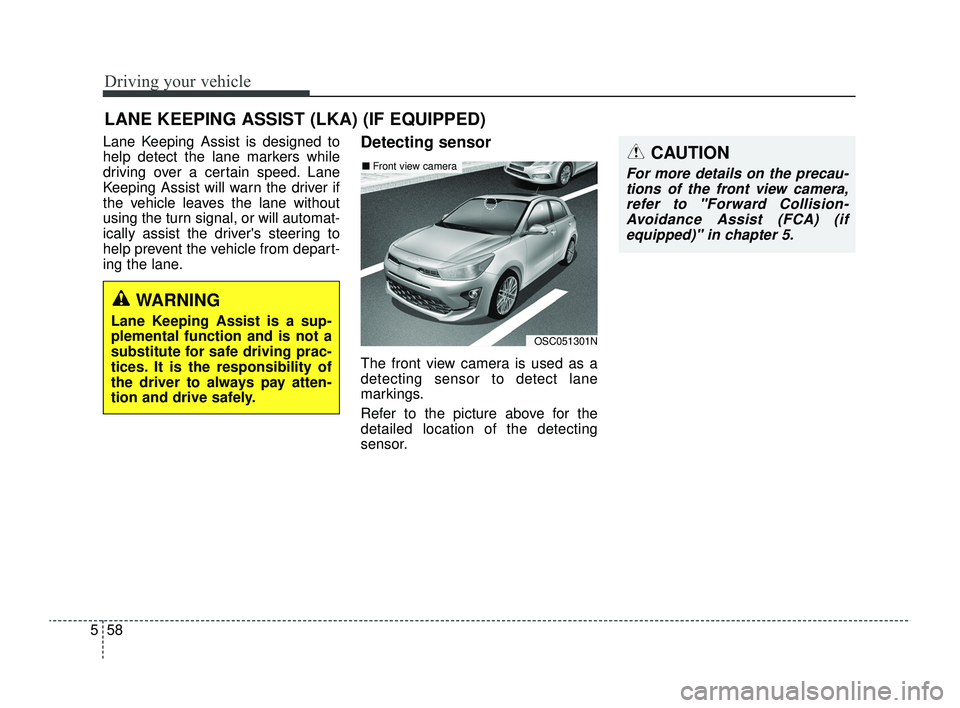
Driving your vehicle
58
5
Lane Keeping Assist is designed to
help detect the lane markers while
driving over a certain speed. Lane
Keeping Assist will warn the driver if
the vehicle leaves the lane without
using the turn signal, or will automat-
ically assist the driver's steering to
help prevent the vehicle from depart-
ing the lane.Detecting sensor
The front view camera is used as a
detecting sensor to detect lane
markings.
Refer to the picture above for the
detailed location of the detecting
sensor.
LANE KEEPING ASSIST (LKA) (IF EQUIPPED)
OSC051301N
■ Front view cameraCAUTION
For more details on the precau-
tions of the front view camera,refer to "Forward Collision-Avoidance Assist (FCA) (ifequipped)" in chapter 5.
WARNING
Lane Keeping Assist is a sup-
plemental function and is not a
substitute for safe driving prac-
tices. It is the responsibility of
the driver to always pay atten-
tion and drive safely.
SC PE USA 5.QXP 9/9/2021 6:19 PM Page 58
Page 300 of 528
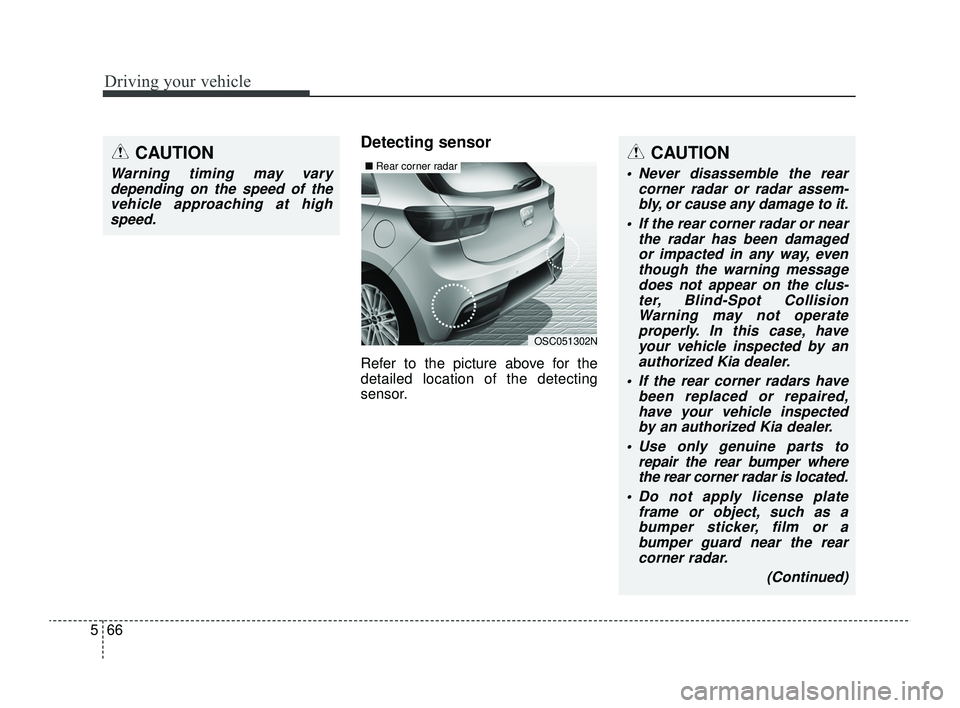
Driving your vehicle
66
5
Detecting sensor
Refer to the picture above for the
detailed location of the detecting
sensor.
CAUTION
Warning timing may vary
depending on the speed of thevehicle approaching at highspeed.
CAUTION
Never disassemble the rear corner radar or radar assem-bly, or cause any damage to it.
If the rear corner radar or near the radar has been damagedor impacted in any way, eventhough the warning messagedoes not appear on the clus-ter, Blind-Spot CollisionWarning may not operateproperly. In this case, haveyour vehicle inspected by anauthorized Kia dealer.
If the rear corner radars have been replaced or repaired,have your vehicle inspectedby an authorized Kia dealer.
Use only genuine parts to repair the rear bumper wherethe rear corner radar is located.
Do not apply license plate frame or object, such as abumper sticker, film or abumper guard near the rearcorner radar.
(Continued)
OSC051302N
■Rear corner radar
SC PE USA 5.QXP 9/9/2021 6:19 PM Page 66
Page 305 of 528

571
Driving your vehicle
Blind-Spot Collision Warning dis-abled
When the rear bumper around the
rear corner radar or sensor is cov-
ered with foreign material, such as
snow or rain, or installing a trailer or
carrier, it can reduce the detecting
performance and temporarily limit or
disable Blind-Spot Collision Warning.
If this occurs, the 'Blind-Spot Safety
system disabled. Radar blocked'
warning message will appear on the
cluster.
Blind-Spot Collision Warning will
operate normally when such foreign
material or trailer, etc. is removed,
and then the engine is restarted. If Blind-Spot Collision Warning does
not operate normally after it is
removed, have your vehicle inspect-
ed by an authorized Kia dealer.
ODL3A050289
WARNING
Even though the warning
message does not appear on
the cluster, Blind-Spot
Collision Warning may not
properly operate.
Blind-Spot Collision Warning may not properly operate in
an area (for example, open ter-
rain), where any objects are
not detected right after the
engine is turned on, or when
the detecting sensor is
blocked with foreign material
right after the engine is turned
on.
CAUTION
Turn off Blind-Spot CollisionWarning to install or remove atrailer, carrier, or another attach-ment. Turn on Blind-SpotCollision Warning when fin-ished.
SC PE USA 5.QXP 9/9/2021 6:20 PM Page 71
Page 309 of 528
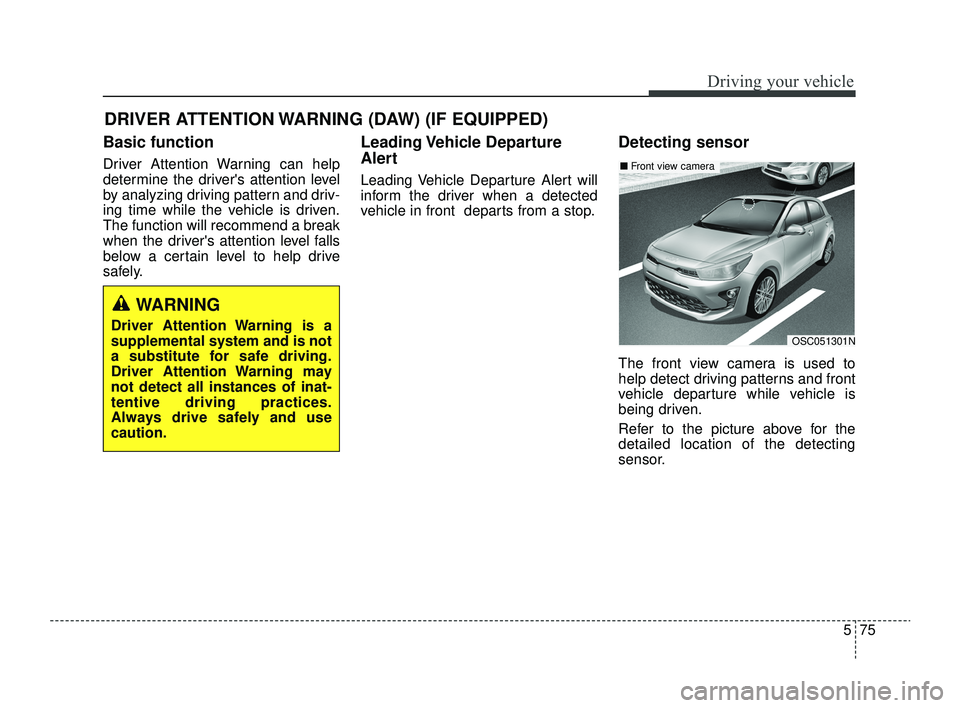
575
Driving your vehicle
Basic function
Driver Attention Warning can help
determine the driver's attention level
by analyzing driving pattern and driv-
ing time while the vehicle is driven.
The function will recommend a break
when the driver's attention level falls
below a certain level to help drive
safely.
Leading Vehicle Departure
Alert
Leading Vehicle Departure Alert will
inform the driver when a detected
vehicle in front departs from a stop.
Detecting sensor
The front view camera is used to
help detect driving patterns and front
vehicle departure while vehicle is
being driven.
Refer to the picture above for the
detailed location of the detecting
sensor.
DRIVER ATTENTION WARNING (DAW) (IF EQUIPPED)
OSC051301N
■Front view camera
WARNING
Driver Attention Warning is a
supplemental system and is not
a substitute for safe driving.
Driver Attention Warning may
not detect all instances of inat-
tentive driving practices.
Always drive safely and use
caution.
SC PE USA 5.QXP 9/9/2021 6:20 PM Page 75
Page 323 of 528
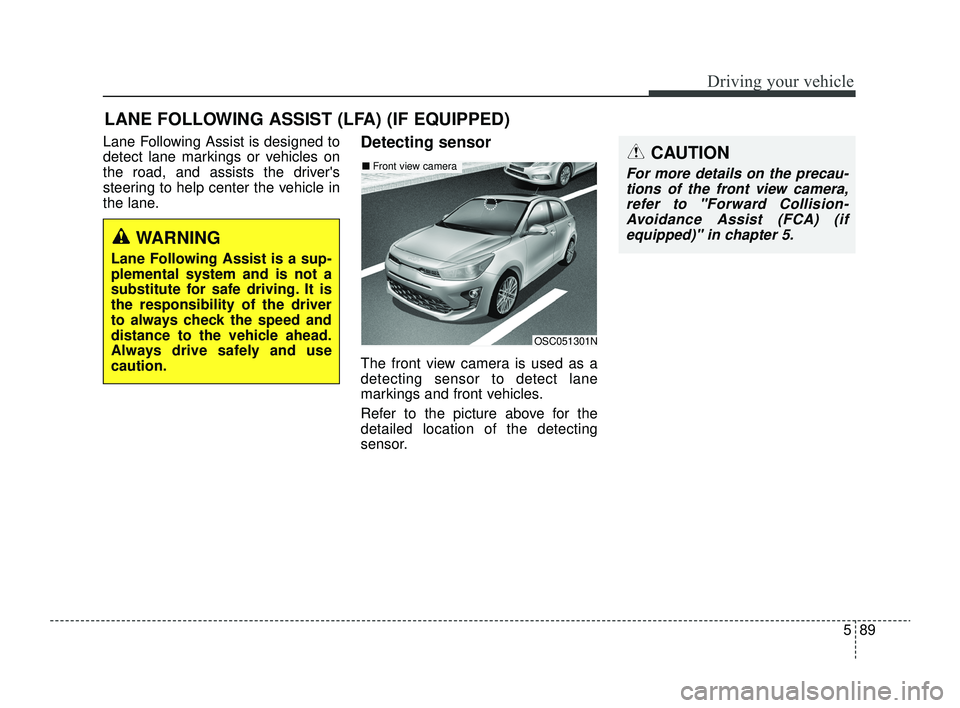
589
Driving your vehicle
Lane Following Assist is designed to
detect lane markings or vehicles on
the road, and assists the driver's
steering to help center the vehicle in
the lane.Detecting sensor
The front view camera is used as a
detecting sensor to detect lane
markings and front vehicles.
Refer to the picture above for the
detailed location of the detecting
sensor.
LANE FOLLOWING ASSIST (LFA) (IF EQUIPPED)
OSC051301N
■Front view cameraCAUTION
For more details on the precau-
tions of the front view camera,refer to "Forward Collision-Avoidance Assist (FCA) (ifequipped)" in chapter 5.
WARNING
Lane Following Assist is a sup-
plemental system and is not a
substitute for safe driving. It is
the responsibility of the driver
to always check the speed and
distance to the vehicle ahead.
Always drive safely and use
caution.
SC PE USA 5.QXP 9/9/2021 6:21 PM Page 89